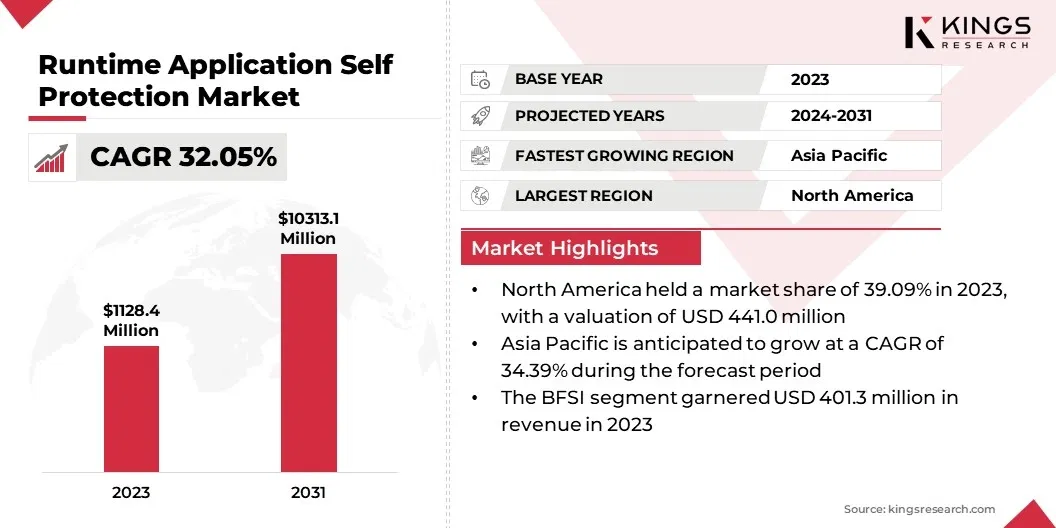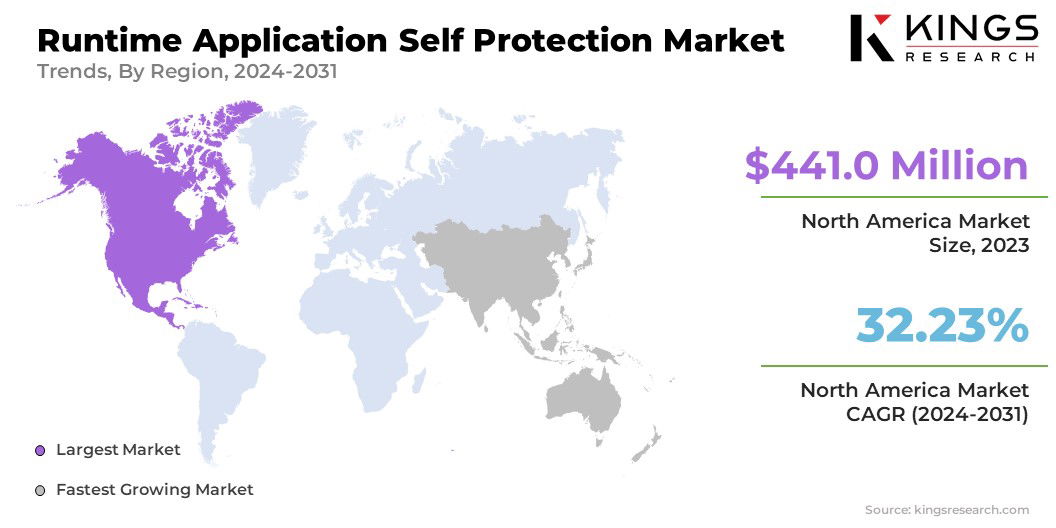ICT-IOT

Runtime Application Self Protection Market

Runtime Application Self Protection Market Size, Share, Growth & Industry Analysis, By Component (Software, Services), By Type (Web Applications, Mobile Applications, API Protection), By Vertical (BFSI, Healthcare, Retail, Government, Telecommunication, Others), and Regional Analysis 2024-2031
Pages : 120
Base Year : 2023
Release : October 2024
Report ID: KR1122
Runtime Application Self Protection Market Size
Global Runtime Application Self Protection Market size was recorded at USD 1,128.4 million in 2023, which is estimated to be valued at USD 1,473.1 million in 2024 and is projected to reach USD 10,313.1 million by 2031, growing at a CAGR of 32.05% from 2024 to 2031. Increasing cybersecurity threats and the proliferation of web and mobile applications are augmenting the growth of the market.
In the scope of work, the report includes services offered by companies such as Imperva, Trend Micro Incorporated, Digital.AI, CrowdStrike Inc., PRADEO, Promon AS, Guardsquare nv, Zimperium, Contrast Security, Inc., Blue Cedar, and others.
The development of AI-powered solutions is transforming the landscape of application security by enhancing threat detection and response capabilities. Leveraging artificial intelligence and machine learning algorithms, these RASP solutions analyze application behaviors in real-time to detect sophisticated and subtle attack patterns. Traditional RASP solutions rely on predefined security rules that advanced cyber threats can bypass.
In contrast, AI-powered RASP systems continuously adapt by learning from evolving attack vectors, making them more resilient. This AI-driven approach enhances threat detection accuracy and reduces reliance on human intervention. This opportunity presents immense potential for the cybersecurity market, as organizations across various industries seek to implement more intelligent and automated security systems.
As zero-day vulnerabilities and advanced persistent threats increase, AI-powered RASP solutions provide businesses with valuable tools to proactively mitigate risks and secure applications. Vendors investing in AI-driven RASP technologies can gain a competitive edge, as enterprises prioritize sophisticated, scalable security solutions in the digital age.
is a security technology that integrates into an application’s runtime environment to monitor, detect, and mitigate threats in real-time. Unlike traditional security tools, RASP operates within the application, providing deeper insight and protection by identifying and blocking malicious activities in real time. The key components of RASP include continuous monitoring, threat detection, and automated response, ensuring application protection even after deployment. This makes it particularly effective against sophisticated attacks such as SQL injection, cross-site scripting, and code injections.
RASP solutions can be categorized into two types: cloud-based and on-premise. The cloud-based variant is highly scalable and easy to integrate into modern architectures, while on-premise solutions offer more control for organizations handling sensitive data.
Verticals such as finance, healthcare, and retail are major adopters of RASP technologies, as they deal with highly sensitive data and are frequent targets for cyberattacks. By providing real-time, adaptive protection, RASP helps these industries maintain regulatory compliance and secure their critical applications.

Analyst’s Review
In the runtime application throughout the document (RASP) market, key players are continuously refining their strategies to stay competitive in the fast-evolving cybersecurity landscape. A prevalent strategy among leading companies is the integration of their RASP solutions with DevSecOps practices to ensure seamless security throughout the software development lifecycle. This integration aligns with the growing demand for security automation, helping organizations reduce vulnerabilities and improve operational efficiency.
Market growth is further fueled by a major focus on cloud-native security solutions, as enterprises increasingly migrate their operations to cloud environments.
- For instance, in September 2024, Guardsquare introduced a new guided approach to mobile application security, enabling development teams to fully protect apps within a day. This innovative solution enhances developer productivity, security visibility, and collaboration between security and development teams. Available for iOS and Android, it simplifies the implementation of robust protection against reverse engineering and tampering, regardless of developer expertise.
Another imperative for success in this market is the ability to innovate and leverage emerging technologies such as AI and machine learning. By integrating these technologies into their RASP offerings, companies are positioning themselves to address more sophisticated threats in real-time.
Moreover, forming strategic partnerships with cloud service providers and large enterprises helps broaden their market reach and enhance product offerings. As competition intensifies, focusing on tailored industry solutions and cost-effective security models is likely to be critical for increasing market share.
Runtime Application Self Protection Market Growth Factors
The rising sophistication of cyberattacks, particularly those targeting application vulnerabilities, is boosting the growth of the runtime application self protection (RASP) market. As hackers adopt advanced techniques such as zero-day exploits and fileless malware, traditional perimeter defenses such as firewalls and intrusion detection systems are insufficient to safeguard applications.
Cybercriminals are increasingly exploiting flaws in applications during runtime, bypassing static security protocols. This shift has led organizations to seek real-time, in-app security solutions such as RASP to detect and mitigate threats during application execution.
- For instance, in June 2024, the Business Continuity Institute (BCI) reported an increase in cyber threats, with 75% of respondents noting increased breach attempts and 39.4% experiencing successful attacks. Phishing, especially credential harvesting, remains prevalent, with 61.3% reporting cyber incidents attributed to phishing, exaceberated by digitalization and the accessibility of advanced AI tools.
RASP solutions offer a proactive approach by analyzing application behaviors and intervening when suspicious activities are detected. This enables organizations to prevent attacks such as SQL injection, cross-site scripting, and malicious code injections, which can have devastating consequences if left unchecked.
With businesses increasingly relying on digital platforms and applications, particularly in sectors such as finance, healthcare, and e-commerce, the need for RASP solutions has become critical. As cyberattacks become more targeted and sophisticated, organizations are prioritizing RASP adoption to safeguard their assets and maintain trust.
The initial deployment cost poses a considerable barrier for many organizations, particularly small and medium-sized enterprises (SMEs), thereby impeding the market expansion. The expenses associated with purchasing, integrating, and maintaining RASP technologies can be significant, mainly due to the need for skilled personnel to manage and monitor these systems.
In addition to the direct costs, organizations must also consider potential downtime during performance impacts, as improperly optimized RASP solutions may introduce latency. These financial considerations often cause hesitation among businesses, especially those with limited IT budgets. However, the long-term benefits of implementing RASP often outweigh the initial investment, as the cost of a successful cyberattack can be much higher, both in terms of financial losses and reputational damage.
To mitigate this challenge, vendors can offer scalable pricing models such as subscription-based services, allowing businesses to pay based on usage rather than incurring substantial upfront cost. Additionally, educating organizations on the return on investment (ROI) from reduced risks and regulatory compliance can justify the initial investment in RASP deployment.
Runtime Application Self Protection Market Trends
The integration of RASP solutions with DevSecOps practices presents a growing trend in the runtime application self protection market. DevSecOps, which stands for development, security, and operations, emphasizes the incorporation of security at every stage of the software development lifecycle rather than considering it an afterthought.
Integrating RASP with DevSecOps enables organizations to embed security directly in applications during development, ensuring that vulnerabilities are identified and addressed early in the process. This continuous security monitoring and protection at runtime help reduce the window of exposure to cyber threats. RASP solutions enhance DevSecOps pipelines by providing real-time visibility into application behavior during runtime, allowing teams to respond immediately to emerging threats.
This integration creates a more proactive security posture to stay ahead of developers and avoid reactive responses to vulnerabilities after deployment. The trend of integrating RASP with DevSecOps is particularly beneficial for organizations that operate in agile environments, where rapid development cycles demand equally agile and adaptive security solutions. It enables faster, more secure software delivery and helps companies maintain a competitive edge in today’s digital landscape.
Segmentation Analysis
The global market has been segmented on the basis of type, application, vertical, and geography.
By Component
Based on component, the market has been divided into software and services. The software segment captured the largest share of 85.05% in 2023, largely attributed to the growing reliance on software-based solutions for cybersecurity, particularly in the application security. Runtime application self protection is primarily a software-based technology, integrated directly into applications to monitor and protect them from internal and external threats in real time.
Organizations across various industries are increasingly adopting software-driven security solutions due to their flexibility, scalability, and ease of integration within existing IT infrastructures. Unlike hardware-based solutions, which are expensive and require ongoing maintenance, software-based RASP solutions offer rapid deployment and updates, enabling a more efficient response to evolving threats.
Additionally, software RASP solutions are gaining traction as businesses migrate to cloud environments and adopt DevSecOps practices, where agile and automated security solutions are essential. The growth of the software segment is further propelled by advancements in AI and machine learning, which enhance the functionality of RASP solutions, making them more adaptive and effective in detecting and mitigating sophisticated cyber threats.
By Type
Based on type, the market has been classified into web applications, mobile applications, and API protection. The web applications segment is expected to witness a staggering CAGR of 32.74% over the forecast period, primarily due to the rapid proliferation of web-based platforms and services across industries.
With the growing digitization of business operations, web applications have become essential tools for communication, e-commerce, banking, healthcare, and other critical sectors. This widespread adoption of web applications has expanded the attack surface, making them prime targets for cybercriminals seeking to exploit vulnerabilities.
RASP’s ability to provide real-time protection for web applications by monitoring, detecting, and mitigating attacks as they occur is leading to its widespread adoption. Furthermore, as organizations migrate their web applications to cloud environments, the need for agile and scalable security solutions has intensified. This growth is particularly evident in industries such as e-commerce, where the protection of sensitive customer data is critical.
By Vertical
Based on vertical, the market has been divided into BFSI, healthcare, retail, government, telecommunication, and others. The BFSI segment led the runtime application self protection market in 2023, reaching a valuation of USD 401.3 million, propelled by the increasing need for advanced application security solutions in a highly targeted industry.
The BFSI sector processes vast amounts of sensitive financial data, making it an attractive target for cybercriminals. With the rise in sophisticated cyberattacks such as phishing, ransomware, and identity theft, financial institutions are facing pressure to secure their digital infrastructure, including web and mobile applications.
- For instance, in 2024, according to the International Monetary Fund, the financial sector has experienced over 20,000 cyberattacks in the past 20 years, resulting in losses exceeding USD 12 billion. These figures highlight the growing threat landscape and urgent need for enhanced cybersecurity measures in the banking and financial services industry.
This increased threat environment has led to a widespread adoption of runtime application self protection solutions within the BFSI sector. RASP enhances security with real-time threat detection, particularly during transactions and data transfers, ensuring vulnerabilities are promptly identified and mitigated.
Regulatory requirements such as GDPR, PCI-DSS, and other compliance standards mandate stringent security protocols for financial institutions, increasing the demand for robust application security solutions such as RASP.
Runtime Application Self Protection Market Regional Analysis
Based on region, the global market has been segmented into North America, Europe, Asia-Pacific, MEA, and Latin America.

North America runtime application self-protection (RASP) market accounted for a substantial share of 39.09% and was valued at USD 441.0 million in 2023. This dominance is primarily attributed to the region's advanced IT infrastructure, high adoption of cutting-edge cybersecurity solutions, and the presence of numerous technology-driven enterprises.
The United States, in particular, has been a at the forefront of this growth, with businesses increasingly focusing on securing their applications amid rising incidents of cyberattacks targeting application layers.
Financial institutions, healthcare providers, and e-commerce platforms, which are highly susceptible to breaches, are investing heavily in RASP solutions to protect sensitive data and ensure compliance with stringent regulatory requirements such as the Health Insurance Portability and Accountability Act (HIPAA) and the California Consumer Privacy Act (CCPA). Moreover, the integration of RASP solutions with cloud platforms, which are widely adopted in North America, has fueled demand.
Asia-Pacific runtime application self protection market is poised to grow at a staggering CAGR of 34.39% over the projection period. This rapid expansion is primarily fueled by rapid digitalization and the increasing frequency of cyberattacks across the region. As businesses in Asia-Pacific expand their online presence, the risk of cyber threats targeting web applications and mobile platforms has grown substantially.
Countries such as China, India, Japan, and South Korea are experiencing a surge in internet usage, e-commerce activities, and cloud computing adoption, all of which require robust cybersecurity measures. The rising awareness of the importance of application-layer security in these economies is propelling the adoption of RASP solutions.
Additionally, governments in Asia-Pacific are strengthening their focus on data protection and cybersecurity regulations, prompting businesses to invest in advanced security technologies such as RASP to meet compliance requirements. The region's booming fintech, healthcare, and retail sectors are particularly vulnerable to cyberattacks, thereby increasong the demand for real-time security solutions.
Competitive Landscape
The global runtime application self protection market report provides valuable insights, highlighting the fragmented nature of the industry. Prominent players are focusing on several key business strategies, such as partnerships, mergers and acquisitions, product innovations, and joint ventures, to expand their product portfolio and increase their market shares across different regions.
Companies are implementing impactful strategic initiatives, such as expansion of services, investments in research and development (R&D), establishment of new service delivery centers, and optimization of their service delivery processes, which are likely to create new opportunities for market growth.
List of Key Companies in Runtime Application Self Protection Market
- Imperva
- Trend Micro Incorporated
- Digital.AI
- CrowdStrike Inc.
- PRADEO
- Promon AS
- Guardsquare nv
- Zimperium
- Contrast Security, Inc.
- Blue Cedar
Key Industry Developments
- April 2024 (Launch): Guardsquare launched the enterprise version of its award-winning mobile application security testing (MAST) tool, AppSweep. Designed for scaling across teams at different stages of app development, AppSweep Enterprise ensures compliance with IT security policies and integrates seamlessly with existing systems. Available in both free and paid versions, it enhances security risk detection for growing organizations.
The global runtime application self protection market has been segmented:
By Component
- Software
- Services
By Type
- Web Applications
- Mobile Applications
- API Protection
By Vertical
- BFSI
- Healthcare
- Retail
- Government
- Telecommunication
- Others
By Region
- North America
- U.S.
- Canada
- Mexico
- Europe
- France
- UK
- Spain
- Germany
- Italy
- Russia
- Rest of Europe
- Asia-Pacific
- China
- Japan
- India
- South Korea
- Rest of Asia-Pacific
- Middle East & Africa
- GCC
- North Africa
- South Africa
- Rest of Middle East & Africa
- Latin America
- Brazil
- Argentina
- Rest of Latin America
CHOOSE LICENCE TYPE
Frequently Asked Questions (FAQ's)
Get the latest!
Get actionable strategies to empower your business and market domination
- Deliver Revenue Impact
- Demand Supply Patterns
- Market Estimation
- Real-Time Insights
- Market Intelligence
- Lucrative Growth Opportunities
- Micro & Macro Economic Factors
- Futuristic Market Solutions
- Revenue-Driven Results
- Innovative Thought Leadership
.webp)